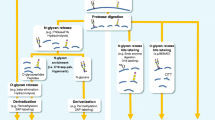Abstract
This chapter provides insights into why proteins are glycosylated and how their glycosylation can be characterized by mass spectrometry. The covalent attachment of carbohydrates to proteins during their biosynthesis is a phenomenon shared by all domains of life. Indeed the majority of proteins in living systems are glycosylated. Their carbohydrates play critical roles in a myriad of biological processes especially those involving recognition. They do this via engagement with carbohydrate binding proteins called lectins. For example mammalian sperm-egg engagement in the first step of fertilization involves carbohydrate-lectin recognition, and the human egg is coated with a carbohydrate sequence called sialyl Lewisx which also plays important recognition roles in the immune system.
Access this chapter
Tax calculation will be finalised at checkout
Purchases are for personal use only
Similar content being viewed by others
References
A. Varki, R. Cummings, J. Esko, H. Freeze, P. Stanley, C. Bertozzi, G. Hart, M. Etzler, Essentials of Glycobiology, 2nd edn. (Cold Spring Harbor Laboratory, Cold Spring Harbor, New York, 2009)
Consortium for Functional Glycomics (CFG) web page, http://www.functionalglycomics.org/fg/
C. Szymanski, B. Wren, Protein glycosylation in bacterial mucosal pathogens. Nature Rev. Microbiol. 3(3), 225–237 (2005)
A. Dell, A. Galadari, F. Sastre, P. Hitchen, Similarities and differences in the glycosylation mechanisms in prokaryotes and eukaryotes. Int. J. Microbiol. 2010, 148178 (2010). doi:10.1155/2010/148178
N. Sharon, H. Lis, History of lectins: from hemagglutinins to biological recognition molecules. Glycobiology 14(11), 53–62 (2004)
M. Fukuda, E. Spooncer, J. Oates, A. Dell, J. Klock, Structure of sialylated fucosyl lactosaminoglycan isolated from human granulocytes. J. Biol. Chem. 259(17), 10925–10935 (1984)
C. Jones, J. Pinkner, R. Rotht, J. Heusert, A. Nicholes, S. Abraham, S. Hultgren, Fimh adhesin of type 1 pili is assembled into a fibrillar tip structure in the enterobacteriacea. Biochemistry. Proc. Natl. Acad. Sci. U.S.A. 92, 2081–2085 (1995)
W. Weis, J. Brown, S. Cusack, J. Paulson, J. Skehel, D. Wiley, Structure of the influenza virus haemagglutinin complexed with its receptor, sialic acid. Nature 333, 426–431 (1988)
M. Sperandio, C. Gleissner, K. Ley, Glycosylation in immune cell trafficking. Immunol. Rev. 230(1), 97–113 (2009)
K. van Gisbergen, M. Sanchez-Hernandez, T. Geijtenbeek, Y. van Kooyk, Neutrophils mediate immune modulation of dendritic cells through glycosylation-dependent interactions between mac-1 and dc-sign. J. Exp. Med. 201(8), 1281–1292 (2005)
S.J. North, J. Jang-Lee, R. Harrison, K. Canis, M. Nazri, A. Trollope, A. Antonopoulos, P.C. Pang, P. Grassi, S. Al-Chalabi, T. Etienne, A. Dell, S.M. Haslam, Chapter two-mass spectrometric analysis of mutant mice. Methods Enzymol. 478, 27–77 (2010)
A. Antonopoulos, S.J. North, S.M. Haslam, A. Dell, Glycosylation of mouse and human immune cells: insights emerging from n-glycomics analyses. Biochem. Soc. Trans. 39(5), 1334–1340 (2011)
P.C. Pang, P. Chiu, C.L. Lee, L.Y. Chang, M. Panico, H.R. Morris, S.M. Haslam, K.H. Khoo, G.F. Clark, W.S. Yeung, A. Dell, Human sperm binding is mediated by the sialyl-lewis\(^{x}\) oligosaccharide on the zona pellucida. Science 333(6050), 1761–1764 (2011)
Author information
Authors and Affiliations
Corresponding author
Editor information
Editors and Affiliations
Rights and permissions
Copyright information
© 2014 Springer International Publishing Switzerland
About this paper
Cite this paper
Dell, A., Sastre, F. (2014). Glycosylation: A Phenomenon Shared by All Domains of Life. In: Delitala, M., Ajmone Marsan, G. (eds) Managing Complexity, Reducing Perplexity. Springer Proceedings in Mathematics & Statistics, vol 67. Springer, Cham. https://doi.org/10.1007/978-3-319-03759-2_7
Download citation
DOI: https://doi.org/10.1007/978-3-319-03759-2_7
Published:
Publisher Name: Springer, Cham
Print ISBN: 978-3-319-03758-5
Online ISBN: 978-3-319-03759-2
eBook Packages: Mathematics and StatisticsMathematics and Statistics (R0)




